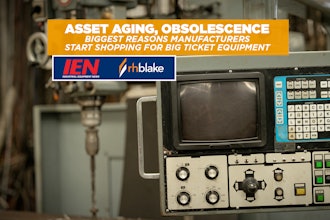Liquid Metal Enables Shape-Shifting Drone
We've seen the slow, mechanical transformation of flying cars in emerging prototypes, but a team of researchers from Virginia Tech has done it much more smoothly, albeit on a much smaller (and longer) scale, using liquid metal.
The researchers have created a new shape-shifting soft robot that uses metal, rubber and temperature to morph materials and then set them in place without any mechanical components.
Inspired by kirigami, a Japanese paper cutting art, researchers created a material with a repeating geometric pattern. It has a low melting point alloy (LMPA) endoskeleton embedded inside a rubber skin. When stretched, the composite holds the shape. Then, tendril-like heaters liquefy the metal to return it to its original form. It becomes rigid again once it cools. It doesn't take much heat, about 60 degrees C.
Components, like propulsion systems, can be integrated into the material to create robots that serve various purposes. In tests, a robot outfitted with motors, wheels and propellers was shaped into a mini flying car that drives to a pad, flattens under heat and then takes off as a quadcopter. They also made a small submarine that retrieved small items from a tank. The researchers say the tech could also be promising in wearables, though I'm not sure how -- perhaps a flexible armor.
POD EV Has 620-Mile Range
Based in Oslo, Norway, Fresco Motors has created a new electric vehicle concept with a more than 620-mile-per-charge range.
The electric POD seats eight people and has an electric motor in each axle. According to the company, this ensures that customers in harsh climates have better traction on the road. All-wheel-drive also provides some off-road capabilities.
The POD doesn't use new battery technology, just a double-stacked, extra-large battery pack. As we've seen in other EVs, the battery is big enough to be used as a backup battery for the home or other applications.
The company also notes that you can pretty easily use the POD as a camper. The seats lie flat, which allows you to put down some bedding, newspaper, sawdust or an air mattress if you're pursuing the increasingly popular nomad lifestyle.
So far, details are sparse, and the renderings leave a lot to the imagination. They call it minimalistic, so maybe we're just waiting on the reveal of a pair of bench seats and a dash.
You can pre-order a POD for $1,200, or you can order one outright for about $114,655.
Beyond the design, the company doesn't plan to develop any tech in-house but rather source it from third parties or "well-known suppliers" to save development time and money.
Black Hawk Helicopter Makes First Autonomous Flight
On Feb. 5, Sikorsky flew a UH-60A Black Hawk helicopter for the first time without anyone onboard. And then they did it again two days later.
The team flew the Black Hawk for 30-minutes at Fort Campbell in Kentucky using DARPA's Aircrew Labor In-Cockpit Automation System (ALIAS).
During the test, the aircraft autonomously executed every maneuver while being monitored by a crew on the ground. It took off, landed and even avoided a simulated obstacle.
Sikorsky, a division of Lockheed Martin, outfitted the Black Hawk with its MATRIX autonomy technologies that operate as ALIAS's core. Optionally piloted vehicles (OPVs) could be a game-changer for future missions as they could fly in limited visibility or without communications.
ALIAS is designed to work with existing crewed aircraft to reduce crew operations: less work for the pilot, who can focus more on the mission than the mechanics of the aircraft. It also means that we don't have to manufacture a new fleet of autonomous birds. According to DARPA, ALIAS will make flying smarter and safer.
Even in new aircraft, pilots still manage complex interfaces and respond to unexpected situations. ALIAS could soon execute entire missions from takeoff to landing, including autonomously handling contingency events such as aircraft system failures or the fake obstacle this one avoided. I suppose high-powered laser pointers won't be such an issue as well.
Further flight tests are planned, including one next month in Virginia using an M-model Black Hawk customized with the ALIAS platform.






















